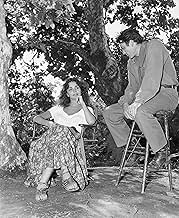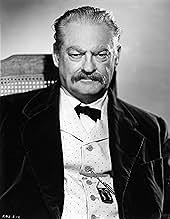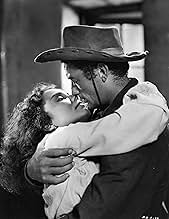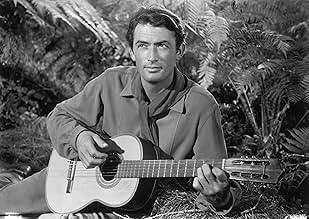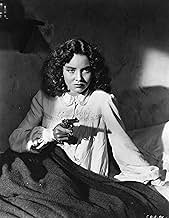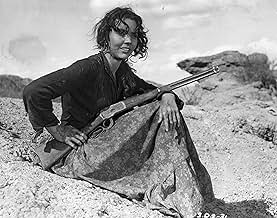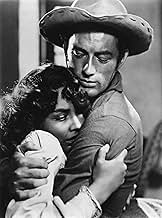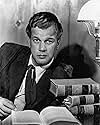IMDb-BEWERTUNG
6,7/10
10.096
IHRE BEWERTUNG
Die schöne, gemischtrassige Pearl Chavez wird zum Mündel der ersten Liebe ihres verstorbenen Vaters und ist hin- und hergerissen zwischen zwei Brüdern, von denen der eine gut und der andere ... Alles lesenDie schöne, gemischtrassige Pearl Chavez wird zum Mündel der ersten Liebe ihres verstorbenen Vaters und ist hin- und hergerissen zwischen zwei Brüdern, von denen der eine gut und der andere böse ist.Die schöne, gemischtrassige Pearl Chavez wird zum Mündel der ersten Liebe ihres verstorbenen Vaters und ist hin- und hergerissen zwischen zwei Brüdern, von denen der eine gut und der andere böse ist.
- Für 2 Oscars nominiert
- 3 Gewinne & 4 Nominierungen insgesamt
Griff Barnett
- The Bordertown Jailer
- (Nicht genannt)
John Barton
- Party Guest
- (Nicht genannt)
Empfohlene Bewertungen
David O. Selznick spent the rest of his life trying to top Gone With the Wind. What other mountains did he have to climb after making the most acclaimed motion picture ever?
In addition he had another obsession, his second wife Jennifer Jones. He was going to make her the greatest leading lady in the history of film.
Well he didn't succeed at either, but it wasn't for lack of trying. Jones herself was in a peculiar position similar to her husband's. She got an Oscar for her first feature film after she changed her name from Phyllis Isley to Jennifer Jones. Selznick knew that she couldn't play saints all her life as she did in The Song of Bernadette. So for this western answer to Gone With the Wind as Pearl Chavez she plays about as opposite a character from Bernadette Soubirous as you can get.
Duel in the Sun got mixed reviews by the critics, but the public ate it up. It's the story of the McCanless family, parents Lionel Barrymore and Lillian Gish and sons Joseph Cotten and Gregory Peck. Cotten is the good son, Peck the bad one. In fact as Lewt McCanless Peck played his worst character until Josef Mengele in Boys from Brazil.
A kissing cousin of their's Jennifer Jones comes to live with them. She's the offspring of an old beau of Lillian's, Herbert Marshall and the Indian wife he ran off with back in the day. Lillian and Herbert were kissing cousins also.
As Pearl Chavez, Jen gets the McCanless boys testosterone going into overdrive. Take one look at her and you can hardly blame them.
One of the not so hidden subtexts of Duel in the Sun is racism. Jennifer's good for a quick roll in the hay, but marriage is out of the question, at least for Gregory Peck. Barrymore's and Peck's racism is overt, the others not quite so, but it's still there.
The negotiations with Louis B. Mayer for Lionel Barrymore must have been interesting. Selznick's former wife was Irene Mayer, Louis's daughter.
One thing with Selznick, he spared no expense. He got the best in talent for this film. Dimitri Tiomkin did the score, King Vidor the direction, Ray Rennahan the color photography which is absolutely stunning.
He even got Bing Crosby to record Gotta Get Me Somebody to Love with Les Paul's guitar. Peck sang it in the film, Crosby's record sold a few platters.
He even got Orson Welles to do the off-screen narration if you don't recognize that voice.
It misses being a classic mainly because Selznick couldn't keep his hands off it. Sometimes the acting is about as subtle as a sledgehammer from all the performers. I'm willing to bet it's Selznick more than Vidor.
Yet it's good entertainment and Duel in the Sun does have its moments.
In addition he had another obsession, his second wife Jennifer Jones. He was going to make her the greatest leading lady in the history of film.
Well he didn't succeed at either, but it wasn't for lack of trying. Jones herself was in a peculiar position similar to her husband's. She got an Oscar for her first feature film after she changed her name from Phyllis Isley to Jennifer Jones. Selznick knew that she couldn't play saints all her life as she did in The Song of Bernadette. So for this western answer to Gone With the Wind as Pearl Chavez she plays about as opposite a character from Bernadette Soubirous as you can get.
Duel in the Sun got mixed reviews by the critics, but the public ate it up. It's the story of the McCanless family, parents Lionel Barrymore and Lillian Gish and sons Joseph Cotten and Gregory Peck. Cotten is the good son, Peck the bad one. In fact as Lewt McCanless Peck played his worst character until Josef Mengele in Boys from Brazil.
A kissing cousin of their's Jennifer Jones comes to live with them. She's the offspring of an old beau of Lillian's, Herbert Marshall and the Indian wife he ran off with back in the day. Lillian and Herbert were kissing cousins also.
As Pearl Chavez, Jen gets the McCanless boys testosterone going into overdrive. Take one look at her and you can hardly blame them.
One of the not so hidden subtexts of Duel in the Sun is racism. Jennifer's good for a quick roll in the hay, but marriage is out of the question, at least for Gregory Peck. Barrymore's and Peck's racism is overt, the others not quite so, but it's still there.
The negotiations with Louis B. Mayer for Lionel Barrymore must have been interesting. Selznick's former wife was Irene Mayer, Louis's daughter.
One thing with Selznick, he spared no expense. He got the best in talent for this film. Dimitri Tiomkin did the score, King Vidor the direction, Ray Rennahan the color photography which is absolutely stunning.
He even got Bing Crosby to record Gotta Get Me Somebody to Love with Les Paul's guitar. Peck sang it in the film, Crosby's record sold a few platters.
He even got Orson Welles to do the off-screen narration if you don't recognize that voice.
It misses being a classic mainly because Selznick couldn't keep his hands off it. Sometimes the acting is about as subtle as a sledgehammer from all the performers. I'm willing to bet it's Selznick more than Vidor.
Yet it's good entertainment and Duel in the Sun does have its moments.
Released in 1946 and directed by King Vidor, "Duel in the Sun" stars Gregory Peck and Joseph Cotton as two rival sons of a ranch baron (Lionel Barrymore) in West Texas in the 1880s. When a striking half-breed (Jennifer Jones) comes to live on the ranch, she inspires love in the mild-mannered, educated son (Cotton) and unpredictable lust in the mocking, wild one (Peck). Lillian Gish plays the mother stuck in the middle while Walter Huston appears as a semi-questionable minister known as The Sinkiller. Charles Bickford is on hand as an older man also interested in the drama mama.
While the movie runs 2 hours and 24 minutes, a full 16 minutes is opening and ending music, which makes the runtime of the story itself just over 2 hours. Speaking of the opening "Prelude" and "Overture," the music (by Dimitri Tiomkin) is thoroughly passé and goes on way too long at 12 minutes before the credits, which last another 1:35. If you can get past that, though, this is a great old Western where the producers pulled out all the stops to entertain. Producer, writer and (uncredited) director David O. Selznick's ambition was to top "King Kong" (1933) and, particularly, "Gone with the Wind" (1939), two other pictures he produced.
Although critics fittingly dubbed it "Lust in the Dust," the movie WAS popular with the masses, no doubt helped by its controversial sexual content (which is tame today) and Selznick's affair with Jones, which broke up both of their marriages. They got married a few years later and it lasted till his death in 1965. Despite its box office success, "Duel" couldn't top "Gone with the Wind" and, being the most expensive film ever made at that point, it only broke even, although it eventually went on to make a profit with a re-release in 1954, etc.
Jones is notable as the heavy-breathing babe, but I personally prefer Joan Tetzel as the fiancé of the older son (Cotton). Also, Peck plays the bad son surprisingly well, considering how he's known for playing more noble protagonists, e.g. "The Big Country" (1958) and "Mackenna's Gold" (1969).
Bottom line: "Duel in the Sun" was just too big of a production to lose. Its story, while decidedly melodramatic, is compelling from beginning to end and there are highlights spiced throughout, including some stunning cinematography, amusing moments with horses and a couple of almost shocking sequences and story turns (e.g. the shootout in the saloon and, later, on the town street). To be expected, there are also some lowlights, but the movie always quickly recovers and maintains its footing. Lastly, there's a valuable moral hidden within the Western soap operatic shenanigans.
The film was shot in Arizona & California (too many places to list). The script was written by David O. Selznick & Oliver H.P. Garrett (and, uncredited, Ben Hecht) suggested by a novel by Niven Busch. ADDITIONAL CAST: Herbert Marshall, Harry Carey, Scott McKay & Butterfly McQueen.
GRADE: A
While the movie runs 2 hours and 24 minutes, a full 16 minutes is opening and ending music, which makes the runtime of the story itself just over 2 hours. Speaking of the opening "Prelude" and "Overture," the music (by Dimitri Tiomkin) is thoroughly passé and goes on way too long at 12 minutes before the credits, which last another 1:35. If you can get past that, though, this is a great old Western where the producers pulled out all the stops to entertain. Producer, writer and (uncredited) director David O. Selznick's ambition was to top "King Kong" (1933) and, particularly, "Gone with the Wind" (1939), two other pictures he produced.
Although critics fittingly dubbed it "Lust in the Dust," the movie WAS popular with the masses, no doubt helped by its controversial sexual content (which is tame today) and Selznick's affair with Jones, which broke up both of their marriages. They got married a few years later and it lasted till his death in 1965. Despite its box office success, "Duel" couldn't top "Gone with the Wind" and, being the most expensive film ever made at that point, it only broke even, although it eventually went on to make a profit with a re-release in 1954, etc.
Jones is notable as the heavy-breathing babe, but I personally prefer Joan Tetzel as the fiancé of the older son (Cotton). Also, Peck plays the bad son surprisingly well, considering how he's known for playing more noble protagonists, e.g. "The Big Country" (1958) and "Mackenna's Gold" (1969).
Bottom line: "Duel in the Sun" was just too big of a production to lose. Its story, while decidedly melodramatic, is compelling from beginning to end and there are highlights spiced throughout, including some stunning cinematography, amusing moments with horses and a couple of almost shocking sequences and story turns (e.g. the shootout in the saloon and, later, on the town street). To be expected, there are also some lowlights, but the movie always quickly recovers and maintains its footing. Lastly, there's a valuable moral hidden within the Western soap operatic shenanigans.
The film was shot in Arizona & California (too many places to list). The script was written by David O. Selznick & Oliver H.P. Garrett (and, uncredited, Ben Hecht) suggested by a novel by Niven Busch. ADDITIONAL CAST: Herbert Marshall, Harry Carey, Scott McKay & Butterfly McQueen.
GRADE: A
Well, it's obvious that Selznick was trying his best to recapture that GWTW magic...but this is an unbelievably inept failure. Here's what you can expect from this overblown sex-western:
--Jennifer Jones (in pancake make-up so orange that she put me more in mind of an Oompa-Loompa than the half-breed we're supposed to see) apparently directed to act as though she's Scarlett O'Hara with a lobotomy and bad grammar.
--Gregory Peck as rogue murdering rapist and the apple of his daddy's eye. At one point even doing a pretty decent vocal imitation of Clark Gable -- too bad it's just the voice.
--Lionel Barrymore lazily repeating his "It's a Wonderful Life" role from the same year -- wheelchair & grumpiness standing in for effort.
--Butterfly McQueen as kerchiefed ditzy maid. Hmmm, wonder where they got that idea?
All in all, a miserable movie experience. You'd think that since they cribbed from the best it'd have turned out better! Go figure.
--Jennifer Jones (in pancake make-up so orange that she put me more in mind of an Oompa-Loompa than the half-breed we're supposed to see) apparently directed to act as though she's Scarlett O'Hara with a lobotomy and bad grammar.
--Gregory Peck as rogue murdering rapist and the apple of his daddy's eye. At one point even doing a pretty decent vocal imitation of Clark Gable -- too bad it's just the voice.
--Lionel Barrymore lazily repeating his "It's a Wonderful Life" role from the same year -- wheelchair & grumpiness standing in for effort.
--Butterfly McQueen as kerchiefed ditzy maid. Hmmm, wonder where they got that idea?
All in all, a miserable movie experience. You'd think that since they cribbed from the best it'd have turned out better! Go figure.
No need to recap the plot.
One thing about this overblown fandango— once seeing it, you won't forget it. How could anyone when everything is done to such tasteless excess. Poor Pearl (Jones). Apparently, Jones was told her part was that of a hot-blooded wench, which she unfortunately took to mean parboiled. It's hard not to laugh at the first hour when she acts like a nympho on steroids, tossing hair and leering wildly like pampas grass in a windstorm. Not far behind is that vintage ham Lionel Barrymore doing his usual blustery bit, like we won't get his hard-bitten patriarch unless he takes it into hyper speed. And who could have guessed that the usually constricted and constrained Gregory Peck could actually over-act. I think it was his first and last time—good thing, too.
It's possible to go on about the unrelenting excess— the sunsets that appear to hemorrhage, a musical score that's as necessary as sugar on molasses, and a loony ending that defies parody. But you get the idea. Too bad so much money and effort went into such a generally overheated result. Only Cotten, Gish and the black stallion come through unscathed. I'm thinking RKO could have made a dozen worthwhile programmers on the same budget. As things turned out, Selznick did his beloved Jones no favors with this one. It's hard to believe the man responsible for Gone with the Wind (1939) is also responsible for this swollen mess.
One thing about this overblown fandango— once seeing it, you won't forget it. How could anyone when everything is done to such tasteless excess. Poor Pearl (Jones). Apparently, Jones was told her part was that of a hot-blooded wench, which she unfortunately took to mean parboiled. It's hard not to laugh at the first hour when she acts like a nympho on steroids, tossing hair and leering wildly like pampas grass in a windstorm. Not far behind is that vintage ham Lionel Barrymore doing his usual blustery bit, like we won't get his hard-bitten patriarch unless he takes it into hyper speed. And who could have guessed that the usually constricted and constrained Gregory Peck could actually over-act. I think it was his first and last time—good thing, too.
It's possible to go on about the unrelenting excess— the sunsets that appear to hemorrhage, a musical score that's as necessary as sugar on molasses, and a loony ending that defies parody. But you get the idea. Too bad so much money and effort went into such a generally overheated result. Only Cotten, Gish and the black stallion come through unscathed. I'm thinking RKO could have made a dozen worthwhile programmers on the same budget. As things turned out, Selznick did his beloved Jones no favors with this one. It's hard to believe the man responsible for Gone with the Wind (1939) is also responsible for this swollen mess.
Everything about 'Duel in the Sun' is overripe: the music, the photography (those red sunsets a la GWTW), the strong emotions and the climactic duel on a blazing desert sun by the two mismatched lovers. Indeed, the excesses are almost operatic in proportion--and yet, a viewer can get caught up in this sprawling western rightly termed "Lust in the Dust" by some reviewers. The rampant sensuality of the steamy scenes between Peck and Jones are emphasized by Dimitri Tiomkin's luscious background score which becomes blistering and intense for the climactic shootout. Overproduced, overacted, overwritten--it still entertains and makes us appreciate the genius of David O. Selznick whose hand on all of the material is quite evident. Jennifer Jones was nominated for her tempestuous Pearl Chavez (but lost to Olivia de Havilland for 'To Each His Own'). Lillian Gish deserved her Oscar nomination. And last but not least, let's not forget Walter Huston, who gives the most realistic and enjoyable performance in the entire film as The Sin Killer--a wickedly funny portrayal. Weakest aspect of the film is Gregory Peck's easygoing villain--his whole performance strikes a false note and is not the least bit convincing. He and Joseph Cotten should have switched their roles--Cotten always made a more believable villain than Peck. Selznick obviously was striving to make a western on the level of GWTW--even including Butterfly McQueen for comic relief. All in all, fun to watch if you don't take any of it seriously. Not exactly a work of art--but definitely worth watching. And, oh, that ripe technicolor!
Wusstest du schon
- WissenswertesAccording to King Vidor, director Josef von Sternberg was hired only as a lighting expert by David O. Selznick in order to give his wife--and the film's star--Jennifer Jones a more glamorous look.
- PatzerThe opening shows saguaro cacti in the valley. The film is supposed to take place in Texas, but southern Arizona is the only place in the US with saguaro cacti, unless they've been transplanted.
- Zitate
The Sinkiller: Under that heathen blanket, there's a full-blossomed woman built by the devil to drive men crazy.
- Alternative VersionenThe original "roadshow" version ran 144 minutes. The additional 16 minutes, over the commonly-shown 128 minute version, consisted of a musical "prelude," an "overture" (which contained a spoken prologue, by Orson Welles), and exit music, but no additional scenes in the film. The two additional opening sequences were each inadvertently given the other's label.
- VerbindungenEdited into Geschichte(n) des Kinos: Une histoire seule (1989)
Top-Auswahl
Melde dich zum Bewerten an und greife auf die Watchlist für personalisierte Empfehlungen zu.
- How long is Duel in the Sun?Powered by Alexa
- What is 'Duel in the Sun' about?
- Is "Duel in the Sun" based on a book?
- Where does this movie take place?
Details
- Erscheinungsdatum
- Herkunftsland
- Sprache
- Auch bekannt als
- Duelo al sol
- Drehorte
- Tucson Mountain Park, Tucson, Arizona, USA(final duel)
- Produktionsfirmen
- Weitere beteiligte Unternehmen bei IMDbPro anzeigen
Box Office
- Budget
- 8.000.000 $ (geschätzt)
- Bruttoertrag in den USA und Kanada
- 20.408.163 $
- Weltweiter Bruttoertrag
- 20.428.771 $
- Laufzeit2 Stunden 18 Minuten
- Seitenverhältnis
- 1.37 : 1
Zu dieser Seite beitragen
Bearbeitung vorschlagen oder fehlenden Inhalt hinzufügen

Oberste Lücke
By what name was Duell in der Sonne (1946) officially released in India in English?
Antwort

